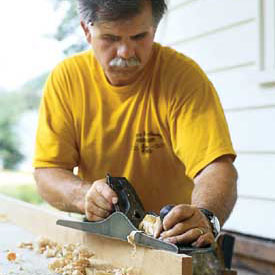See the Saw Stop in action
The Saw Stop – an interesting new advance in safety technology – is a very impressive thing to see. Basically, the saw can sense the difference in electrical conductivity of the materials it is cutting. If the blade is only cutting wood, the saw just hums away. But, if the blade contacts your finger, it triggers a safety mechanism that stops the blade almost immediately and drops it below the table top. Instead of an amputation, you’ll only have a small scrape where the saw’s teeth touched your skin.
Regardless of how you feel about the saw or safety equipment on your machinery, seeing this in action on high-speed film is very impressive. The Discovery Channel show Time Warp trained its high-speed cameras on the saw and triggered the guard. The video shows the dramatic results of what forces are involved in stopping a common 10″ diameter table saw blade.
Of course, you must remember to never, never, NEVER try this at home! Saw Stop is – and should always be considered – a last line of defense against injury. There is no substitute for following sound safety practices when using a table saw.

 Leave it to the guys at the longest-running home improvement show to tackle the task of teaching their readers how to choose and use hand planes.
Leave it to the guys at the longest-running home improvement show to tackle the task of teaching their readers how to choose and use hand planes. Anyone who has watched an episode of Woodworks has seen the creativity, skill and calm demenor of David J. Marks. Sure, this Santa-Rosa, California based woodworker is famous for his shows, but they only touch the surface of this extremely talented man.
Anyone who has watched an episode of Woodworks has seen the creativity, skill and calm demenor of David J. Marks. Sure, this Santa-Rosa, California based woodworker is famous for his shows, but they only touch the surface of this extremely talented man. So, you want to build a bookcase with some shelves to hold a few nick-nacks in the living room. Rather than spend lots of money, you opt to build them out of painted MDF. After a few months of holding ceramic kitties and a vase of flowers, your spouse says, “Don’t you think it wold be cool if we put my 1957 collection of the Encyclopedia Brittanica up there? They look so good.”
So, you want to build a bookcase with some shelves to hold a few nick-nacks in the living room. Rather than spend lots of money, you opt to build them out of painted MDF. After a few months of holding ceramic kitties and a vase of flowers, your spouse says, “Don’t you think it wold be cool if we put my 1957 collection of the Encyclopedia Brittanica up there? They look so good.” A person identified as Legozilla has created – in Legos – a complete replica of the New Yankee Workshop. Complete with a little whiskered Norm Abram.
A person identified as Legozilla has created – in Legos – a complete replica of the New Yankee Workshop. Complete with a little whiskered Norm Abram. Tucked away in the small California coastal town of Fort Bragg, the Fine Furniture program at the College of the Redwoods, Mendocino Coast campus is a national treasure. Established in 1981 by master woodworker James Krenov, this program is one of the world’s most famous and respected. The work turned out by graduates is truly inspired.
Tucked away in the small California coastal town of Fort Bragg, the Fine Furniture program at the College of the Redwoods, Mendocino Coast campus is a national treasure. Established in 1981 by master woodworker James Krenov, this program is one of the world’s most famous and respected. The work turned out by graduates is truly inspired.